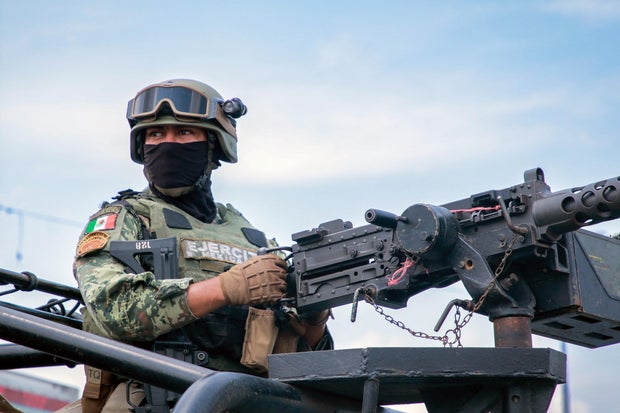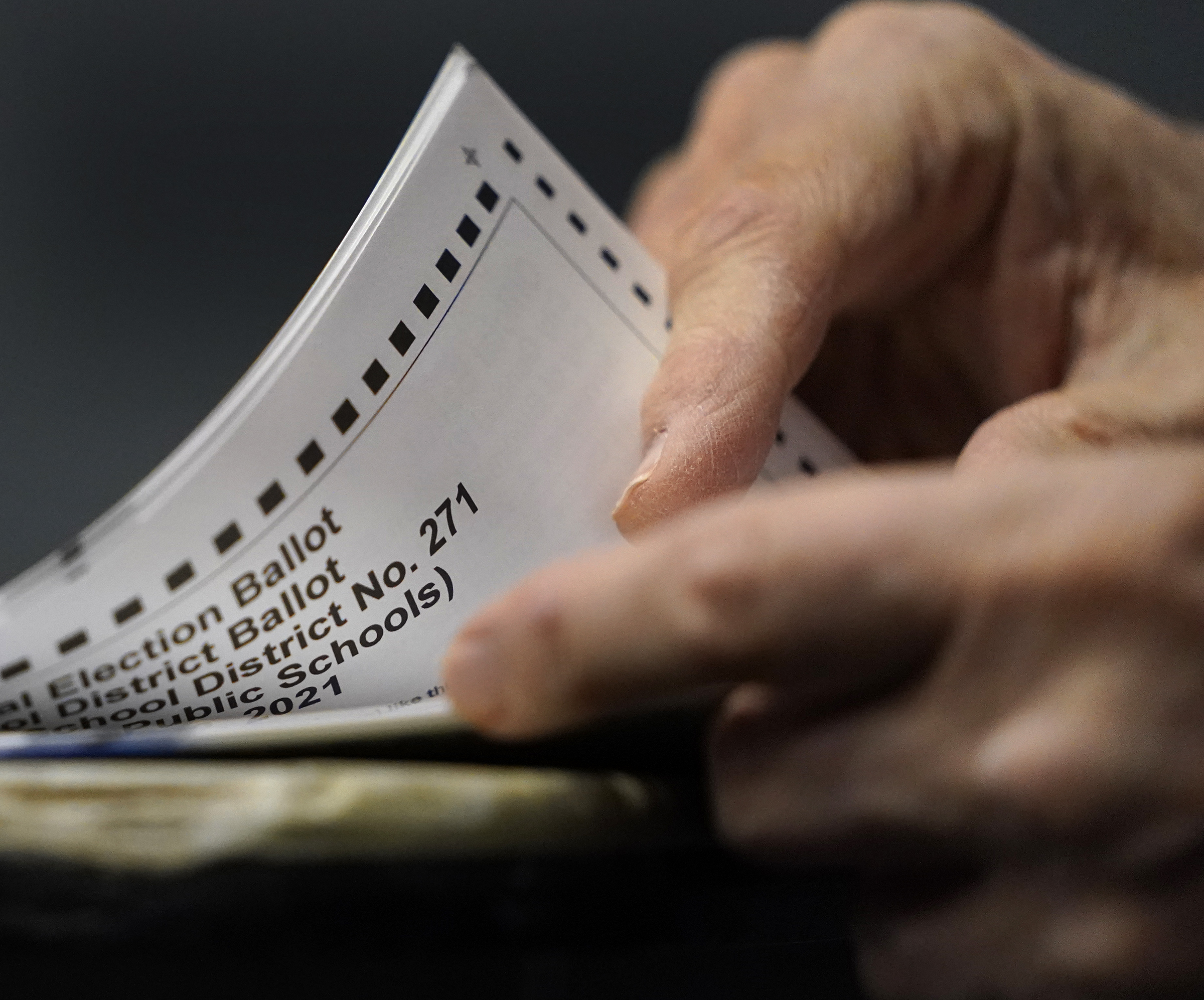CBS News
Gold prices are climbing. What experts say about investing now

Claudia Marcovici/Getty Images
The price of gold has soared to new heights in 2024, with gold futures surging 14.49% since January 2, 2024. Gold’s price per ounce also hit a new all-time high recently following several peaks. In early March, the price punched through to $2,160 per ounce — then a record high. Since then, the price has continued its upward trend, climbing toward its current price of $2,346.33 per ounce (as of April 15).
Evidence that gold was on an upward price trend could be seen in 2023 when gold investing hit an 11-year high as institutional investors turned to gold amid stubborn inflation and the high interest rates aimed at curbing it. So, what’s responsible for gold’s upward trend? And, amid surging gold prices, is it a good time to buy gold? Here’s what the experts say.
Learn more about your gold investing options online today.
Gold prices are climbing. What experts say about investing now
We consulted several gold experts to better understand the current gold investing environment. Here’s what they said.
Why gold is surging
Alex Ebkarian, COO and co-founder of Allegiance Gold, says the price of gold “shot higher and beyond [record highs] due to a confluence of economic and geopolitical issues like rising inflation, a weakening dollar and ongoing geopolitical tensions.
Ebkarian also points to central banks’ activity as a contributing factor behind gold’s rising prices.
“Central banks, led by BRICS Plus nations, are buying gold at a faster pace and faster rate each month. We are seeing more investments led by central banks in gold as opposed to U.S. treasuries,” Ebkarian says.
Plus, the expectations that the Federal Reserve would be dropping interest rates multiple times in 2024 may have contributed to the rising price of gold, says Michael Ashley Schulman, CFA and partner at Running Point Capital Advisors.
“If the Federal Reserve decides to lower rates, as anticipated by many analysts, the dollar might weaken, potentially leading to an increase in the relative value of gold. Lower interest rates also enhance the attractiveness of non-interest-bearing assets like gold,” says Schulman.
“In other words, gold may be on an uptrend and hitting new highs partially based on speculation that the Fed will lower interest rates and the dollar will weaken,” Schulman says.
Explore how gold investing could benefit your portfolio now.
Should investors buy gold now?
Given the soaring price of gold, it’s reasonable to question whether there’s more room for growth and whether investors should buy now. Joe Cavatoni, market strategist, North America, at the World Gold Council, anticipates that there will be continued gold strength due to numerous factors.
“The environment is strong for gold’s performance and our research indicates that when the U.S. market experiences Fed rate cuts, the gold price has performed favorably with an average return of over 8% in the months following,” says Cavatoni.
Gold’s historical performance is another reason to consider investing in the yellow metal, as Ebkarian points out.
“Gold’s 400%+ performance over the past twenty years clearly demonstrates that it’s a very good long-term investment and a great portfolio diversifier,” Ebkarian says.
What should gold investors be aware of?
While gold is often seen as a store of value, the price of gold can still be volatile, especially in the short term. It’s also essential that new investors understand gold isn’t an income-producing asset. It doesn’t generate dividends or interest, so you’re strictly relying on the price appreciation for your returns.
Also, remember that historically, gold may underperform compared to the stock market. Over the last 40 years, gold’s price has appreciated 510%, falling considerably short of the S&P 500’s 3,200% increase over the same period. And while gold has outperformed the S&P 500 so far in 2024, it may be better to consider gold as a store of value that can stabilize your portfolio rather than focusing solely on its returns.
Timing the market may also be a fool’s errand, another reason it’s best to invest in gold for its numerous benefits over price appreciation.
“It’s hard to predict how high any metal will rise because there are always multiple economic events and geopolitical factors at play, which influence price movement,” Ebkarian notes.
The bottom line
Generally, gold’s benefits as a hedge against inflation and safe haven make it a useful option worth considering right now. But experts often recommend allocating no more than 10% of your portfolio to gold. You might also consider consulting your financial advisor to determine if gold aligns with your long-term financial plan.
CBS News
How dogs wearing backpacks are helping to rewild an English woodland

Lewes, England — In an urban nature reserve in a small town about two hours south of London, you’ll find the Lewes Railway Land urban nature reserve teaming with life — including a lot of humans and their companions.
“We get lots of people come onto the reserve — which we want — lots of dog walkers,” Dylan Walker, with the Railway Land Wildlife Trust that manages the green oasis, told CBS News. “Inevitably, that has an impact on the habitat.”
After years of heavy use, the reserve has suffered a little for its popularity, losing some native plant species. But Walker is hoping to bring that biodiversity back.
“We were kind of going, what could we do here?” Walker said. They found the answer in a backpack, designed specifically for dogs.
CBS News
“We’ve got our seed and sand mix here, of our native wildflowers and grasses, and we’re going to put them inside the pack,” Walker explained, noting the importance of ensuring that any seeds spread deliberately in a natural area must be native to the region.
Small holes allow the seeds inside to drop out as dogs move around.
Ruthie Martin tested it out on her daughter’s golden doodle when she came to the reserve for a walk.
“They don’t mind the packs on their backs,” Martin said of the canine seed sowers.
More than 300 years ago, wolves roamed the U.K., often covering up to 100 miles in a single night. Walker said they’d pick up seeds in their fur and drop them in new places.
“It’s really great to have this kind of project where we could use our beloved pets to imitate the behavior of these wild animals,” said Martin.
It’s an idea that initially came from two sisters in Chile, whose backpack-wearing dogs have been helping to regrow forests destroyed by wildfires.
Organizers in the U.K. say it could take a couple years to see the full impact of the pilot project on the reserve.
CBS News
Will 988 call the police? Data suggests 1% of mental health crisis calls get “involuntary” rescues

Many people in mental health crisis fear that if they dial 988, law enforcement might show up or they might be forced to go to the hospital.
But getting sent that kind of “involuntary emergency rescue” happens to around 1% of callers, suggests new data from Vibrant Emotional Health, the administrator of the 988 Lifeline for suicide and mental health crises.
“Involuntary intervention is the last resort. We want to make sure we’re collaborating and engaging with people in crisis and empowering them, so we don’t need to go in that direction,” said Christopher Drapeau, Vibrant’s director of research and evaluation.
A Pew Charitable Trusts survey last year cited by Vibrant’s white paper found that around 1 in 5 adults worry that law enforcement would be sent after them for using 988 or that they might be forced to go to the hospital.
According to 988’s policies, counselors are urged to use “the least invasive intervention” possible to respond to suicide attempts. But if other attempts to deescalate fail, then counselors can summon other emergency response services like an involuntary rescue.
Counselors for 988 do not have the ability to track the exact location of callers. But the Substance Abuse and Mental Health Services Administration or SAMHSA, which oversees Vibrant and the hotline, says in “rare situations” that counselors are able to ask a 911 dispatcher to use “geolocation services” to try and find where a call is coming from.
It is not clear from the data what percentage of the “involuntary” rescues relied on police responding to calls, as opposed to paramedics or another kind of emergency response.
“We haven’t been this transparent in the past. So we want to acknowledge that, and show people that this is what we have,” Drapeau told CBS News of the white paper he authored.
Drapeau said the white paper is his team’s first evaluating the performance of 988 and is the most comprehensive look at the topic to date. The idea for the report came from talks with SAMHSA officials.
Law enforcement have often been the go-to for 911 dispatchers responding to suicide attempts. Advocacy groups have called for more jurisdictions to fund “mobile crisis teams” that can respond to suicide attempts with medics and behavioral health professionals, instead of police.
“If somebody attempted suicide during the call and had a medical injury as a result, you need to respond to that. So I don’t know if we could completely abolish all involuntary interventions,” Drapeau said.
“These numbers may not be perfect”
Vibrant’s white paper focuses on two snapshots of data that come largely from when the line was a 1-800 number, before the nationwide launch of the easier-to-remember 988 shortcut to reach a counselor during a mental health crisis.
The largest snapshot in the paper still only spans around 2 million calls made from 2019 through 2023, tallied from a fraction of the now more than 200 locally run crisis centers that underpin the network.
For context, more than 400,000 calls were routed by the 988 network in July alone.
“We acknowledge the limitations of these data. These numbers may not be perfect. They may differ if we had every single center reporting data, if we had a more precise definition, maybe it changes. But it appears today that the vast majority of 988 calls do not involve emergency services intervention,” said Drapeau.
Of those nearly 2 million calls, the white paper tallies around 2% resulting in emergency services – both “voluntary” and “involuntary” – being sent in response to calls.
Callers categorized by counselors as being at “imminent risk” of suicide, a much narrower group, had emergency services sent to them at a higher rate.
Among those, a quarter got “voluntary dispatches” — with the consent of the callers — while another quarter got “involuntary” rescues.
Better data is in the works. While current figures rely on a mix of requirements and voluntary reporting, a Vibrant spokesperson said it is working with SAMHSA to develop a national standard for what metrics all centers will be required to report in the future.
A plan drawn up by SAMHSA in April calls for states to submit data to the agency on the number of contacts that result in law enforcement being sent.
Another evaluation planned by Vibrant will try to refine the definition of when to deem a caller at “imminent risk” and how to handle those cases. Completing that evaluation will likely take a couple of years, Drapeau said, and will help them figure out how to move from involuntary to more collaborative interventions.
CBS News
Over 30 killed in Mexico cartel stronghold as violence rages after Sinaloa leaders detained in U.S.

Eleven more people have been killed in a wave of violence in a Mexican cartel heartland shaken by gang infighting, authorities said Sunday.
The latest fatalities included five men whose bodies were found on a highway south of the city of Culiacan, the Sinaloa state prosecutor’s office said in a daily update.
More than 30 people have been reported dead in a week of bloodshed in Sinaloa, although authorities did not specify how many were believed to be linked to the cartel infighting.
The clashes follow the dramatic arrest on U.S. soil on July 25 of Sinaloa Cartel co-founder Ismael “El Mayo” Zambada, who claimed he had been kidnapped in Mexico and delivered into US custody against his will. Zambada pleaded not guilty last week in New York in a drug trafficking case that accuses him of engaging in murder plots and ordering torture.
Zambada, 76, was detained along with Joaquin Guzman Lopez, a son of El Chapo, who is serving a life sentence in the United States.
The violence is believed to pit gang members loyal to El Chapo and his sons against others aligned with Zambada, who pleaded not guilty to a raft of charges in a New York court Friday.
Schools were closed Thursday and Friday due to the violence and the governor said Sunday’s Independence Day festivities had been canceled.
The United States on Thursday issued a security alert because of “reports of car thefts, gunfire, security forces operations, roadblocks, burning vehicles and closed roadways” in the vicinity of Culiacan.
IVAN MEDINA/AFP via Getty Images
In an unexpected twist, last month Mexican prosecutors said they were bringing charges against Guzmán for apparently kidnapping Zambada — but it also cited another charge under an article of Mexico’s criminal code that defines what he did as treason.
Nowhere in the statement does it mention that the younger Guzmán was a member of the Chapitos — “little Chapos” — faction of the Sinaloa cartel, made up of Chapo’s sons, that smuggles millions of doses of the deadly opioid fentanyl into the United States, causing about 70,000 overdose deaths each year. According to a 2023 indictment by the U.S. Justice Department, the Chapitos and their cartel associates used corkscrews, electrocution and hot chiles to torture their rivals while some of their victims were “fed dead or alive to tigers.”
El Chapo, the Sinaloa cartel’s founder, is serving a life sentence in a maximum security prison in Colorado after being convicted in 2019 on charges including drug trafficking, money laundering and weapons-related offenses.
Last year, El Chapo sent an “SOS” message to Mexico’s president, alleging that he has been subjected to “psychological torment” in prison.






